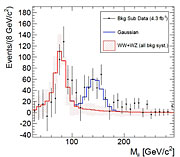- Number 335 |
- April 18, 2011
Intriguing peak in particle collision data

The CDF experiment found
evidence for an unexpected
peak (blue) in proton-
antiproton collision data.
An international collaboration of scientists at DOE’s Fermi National Accelerator Laboratory has found evidence for a peak in a specific data sample of the proton-antiproton collisions recorded by the Collider Detector at Fermilab experiment. The unexpected peak presents an excess of particle collisions that produced a W boson accompanied by two hadronic jets. It is the kind of peak that, if confirmed, scientists associate with the existence of a particle. The significance of the CDF data excess is 3.2 sigma, which means that there is less than a 1 in 1375 chance that the effect is mimicked by a statistical fluctuation. CDF scientists point out that particle physicists only consider a result at 5 sigma to be a discovery.
The features of this intriguing excess exclude the possibility that this peak might be due to a Standard Model Higgs boson or a supersymmetric particle. Instead, the excess might be explained by the production of a new, unknown particle with a mass of about 140 GeV/c2 that is not predicted by the Standard Model, the current standard theory of the fundamental laws of particle physics. The result, under internal review by the CDF collaboration for the last eight months, was submitted to Physical Review Letters and posted on the arXiv.
The current analysis is based on 4.3 inverse femtobarns of collision data. The CDF collaboration will repeat the analysis with at least twice as much data to see whether the data peak gets more or less pronounced. Other experiments, including the DZero experiment at Fermilab and the Large Hadron Collider experiments at the European laboratory CERN, will look for a particle of about 140 GeV/c2 in their data as well. Their results will either refute or confirm the CDF result.
[Kurt Riesselmann, 630.840.5681,
kurtr@fnal.gov]
